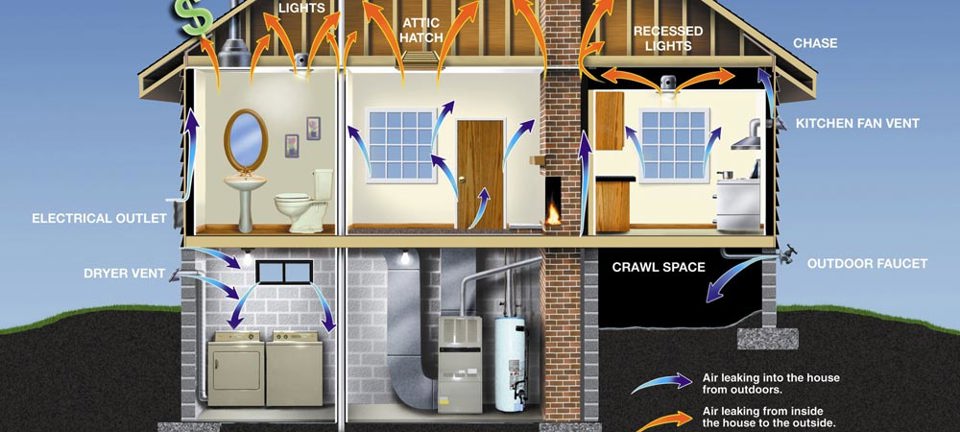
What to Do When Air Leaks Around Your Windows
During the colder months, it's common that people find out that their windows are leaking air into their home. Air leaks in your home are anywhere that air makes its way in to the home from the outside, or to the outside from the interior. This is often why you have a draft near your windows or doors or even other places in your home.
These leaks decrease the efficiency of your heating and cooling system, degrade inside air quality, and can cause other significant issues. So what do you do when air leaks around your windows? We'll get into that in this post.
Use the links below to skip ahead:
What causes air leaks around windows?
Over time, windows may allow air to come through the window frame, resulting in an air leak. This is often due to changing weather.
As humidity and temperature increase and decrease, window frames expand and contract. As they do this, the sealant around the window is stressed. If the seals are dried out or otherwise compromised, they may crack and allow air and moisture through.
In addition to changes in temperature, seals can also fail due to age. Eventually, over time and exposure seals will wear down.
Still, the most common cause of leakage is the weather, and the more extreme the weather in your area and the more exposed the windows are, the more likely this is to happen.

Seal failure can cause additional problems in the window including window fogging, moisture leaks, window rot in wooden frames, and more. If you feel a draft or air leak around your window and you haven't noticed these other problems it’s a good idea to get it checked out.
Where are air leaks commonly found?


The primary cause of air leaks in windows is failed seals but windows are made of multiple components and so there are multiple places where air can pass through.
- Through the glass in the sash if the seal or glass is broken
- Through caps in the caulking around the window frame
- Through gaps in the material of the frame or sash
With so many opportunities for air infiltration it's important to to prevent the leaks. So how do you prevent them and what do you do when you find an air leak in your window?
Can air leaks be repaired?


When asking if air leaks can be repaired, the answer is sometimes. Much of the time replacing seals or using caulk or sealing foam in certain areas can repair an air leak. As a general rule:
- In areas where gaps are less than ¼ inch, use caulk to seal the area.
- If the area is greater than ¼ inch of a gap, use sealing foam.
- If there is a seal where a window opens or closes, replace the seal.
The exception to these rules is if there is significant structural damage, in which case you may need to replace certain components or structural elements in order to seal the leak.
It's best to consult a repairman with window experience before adding sealants to a window. Some sealants are better than others for certain materials and there are areas where sealant doesn't belong.
How to prevent window air leaks
Preventing window leaks begins with a good installation. If you're in the market for replacement windows make sure that the team doing the installation is experienced by checking their reviews.
After your windows are the best you can do is regularly clean the windows, inspect them for damage or wear and tear, and make repairs before the air leaks grow and become other problems (if air is getting in who's to say moisture isn't also a problem).
The first is a physical inspection. You can take a walk around your home and look for air leaks in several different areas including around your windows. But what are you looking (and feeling) for?
Look for gaps under and around windows and doors. Also check for damage like cracks, holes, rodents, or other pest holes, in the area. You'll want to look specifically at:
- the exterior window frames and corners,
- door frames, and the area around them.
Use this time to look for damage around other parts of your home. Damage in the siding, roof, and exposed foundation can all cause air leaks and other problems.
We sometimes get calls about water or air leaks around windows that are actually caused by problems in the roofing or siding.
If you do your inspection on a day that is windy you can “feel” air leaks on the back of your hand.
You can also use an incense stick to do this. If the smoke moves either toward the inside or the outside rather than straight up, you may have an air leak. Remember to turn off your HVAC system before you attempt this. Otherwise, the heater or AC will also disturb the incense smoke.
But what about those air leaks you really can’t see? This is where a pressure test comes in, it's also known as a blower door test. Professionals conduct a test where they depressurize your home and do an energy evaluation.
The results will let you know where the air leaks are, how severe they are, and more. These tests often come with recommendations regarding what to fix and how.
If your window is covered under warranty do not attempt any fixes without first reviewing the warranty and contacting the manufacturer. If the warranty is still valid, the manufacturer may be able to provide suggestions or solutions.
Do I need to replace my windows?
If your windows are leaking, do you need to replace them? The answer is “maybe.” When you need to replace a window can be determined by asking:
- Is there structural damage to the sill, the sash, or other areas of the window frame? If the answer is yes, especially if you have window rot or other issues, you likely need a window replacement.
- Is the glass cracked? If the glass, even just the outer or inner pane, is cracked, your best option is usually replacement but if it's just one window you could also choose glass replacement.
- Is the window fogging between panes? If you are getting fogging between window panes, you may have a leak around the sash, and window replacement is going to be the best solution.
Some air leakage around windows is normal but if you feel a draft then you know you've got a problem. You can learn more about air leakage ratings and NFRC labels in the suggested posts linked below.
Oops!
We don't currently serve your area but do want to help you plan your project. Try our Build & Price tool to get an idea of window & door costs within DFW. Your area may be higher or lower but at least you'll have some idea of the price.
Thanks for stopping by.







